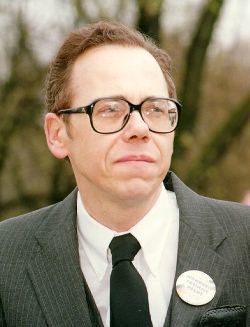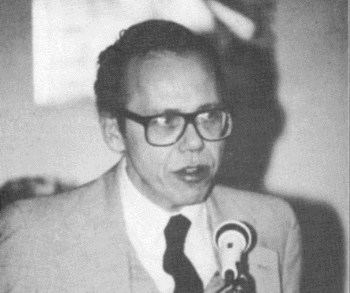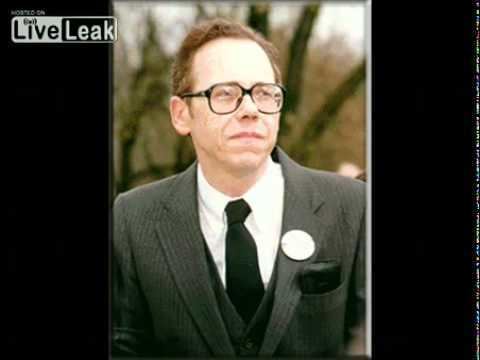Name Fred Leuchter Role Author | Books Leuchter report | |
 | ||
Full Name Fred Arthur Leuchter, Jr. Movies Mr. Death: The Rise and Fall of Fred A. Leuchter, Jr. People also search for Errol Morris, Caroline Leuchter, Michael Williams | ||
Mr. Death: The Rise and Fall of Fred A. Leuchter, Jr.
Fred Arthur Leuchter Jr. (born February 7, 1943) is an American Holocaust denier who is best known as author of the "Leuchter report," a pseudoscientific document that alleges there were no gas chambers at Auschwitz-Birkenau. Prior to this, he had been contracted by the authorities of several states in the U.S. to improve the design of instruments for capital punishment, but he no longer does so. Leuchter was charged in Massachusetts with having misrepresented himself to penitentiaries as an engineer, despite having no relevant qualifications; Leuchter plea bargained with state prosecutors, and received two years probation. He has also been accused of running a "death row shakedown," in which Leuchter threatened to testify for the defense in capital cases if he was not given contracts for his services by that state.
Contents
- Mr Death The Rise and Fall of Fred A Leuchter Jr
- Education and career
- Fred Leuchter Associates
- Allegations of dishonest court appearances
- Zndel trial and investigation at Auschwitz
- Aftermath
- Repetition of Leuchters examination
- Documentary
- Works
- References

Leuchter became internationally known for his testimony in defense of Holocaust denier Ernst Zündel in 1988. His study for Zündel's trial has been referred to as the Leuchter Report since it was published by Zündel with that title. Leuchter's work is often presented by Holocaust deniers as scientifically-based evidence for Holocaust denial. However, his research methods and findings were discredited in a 1999 Errol Morris documentary on the controversy, entitled Mr. Death: The Rise and Fall of Fred A. Leuchter, Jr., as well as elsewhere.

Education and career
Leuchter was born on February 7, 1943 to Fred Arthur Leuchter, Sr. in Malden, Massachusetts.
Leuchter received a Bachelor of Arts degree in history from Boston University in 1964. He holds patents for a geodetic instrument and an electronic sextant. In 1991 Leuchter faced charges of practicing engineering without a license issued by the Board of Registration of Professional Engineers and of Land Surveyors, which regulates professional engineers, a violation of Massachusetts law. As a result of those charges, Leuchter signed a consent decree with the board, in which he stated that he was not and had never been registered as a professional engineer, despite having represented himself as one. He settled with prosecutors by serving two years of probation and agreeing to stop disseminating documents in which he presented himself as an engineer, including the Leuchter Report. In a speech given over a year later, Leuchter claimed that:
a spurious criminal complaint was filed against me in the Massachusetts court system with the intent of destroying my reputation by putting me in prison for three months.
In fact, the Board of Registration of Professional Engineers and of Land Surveyors licenses the following engineering professionals as of 2017:
Aeronautical, Agricultural, Architectural, Chemical, Civil, Control Systems, Electrical, Environmental, Fire Protection, Heating & Ventilation, Industrial, Land Surveyor, Mechanical, Metallurgical, Mining and Mineral, Naval Architecture, Nuclear, Petroleum, Safety, Sanitary, Structural. The Board no longer, but has in the past, also licensed in the following disciplines: Aeronautical/Aerospace, Architectural Marine, Astronautical, Ceramic, Construction, Corrosion, Electronic, Engineering Physics, Geotechnical, Highway, Manufacturing, Marine, Materials, Plumbing, Quality, Railroad, Systems, Traffic, Transportation
Leuchter attributed the actions of the regulatory board against him to "Jewish pressure."
According to The New York Times, before selling execution equipment Leuchter had been a dealer in military surveillance equipment.
Fred Leuchter Associates
Leuchter started Fred Leuchter Associates, in which he sold services to several states to help them maintain, improve, document, and ascertain the effectiveness of their equipment for administration of capital punishment. His initial work was with electric chairs, starting in Tennessee. Leuchter's broader claims are that his work in this area is humanitarian, providing greater respect for both guards and those to be executed. He also claims that he offered his services at considerable economy: off-the-shelf parts, labor, and a 20% profit. By his own account, consultation among various state government agencies spread his reputation from Tennessee to other states, and further assignments followed. Leuchter "aggressively solicited business," and in 1985 the state of New Jersey purchased Leuchter's proposal for a lethal injection system for $30,000.
On October 24, 1990 The New York Times described him as "self-proclaimed execution expert and manufacturer of death machinery." It quoted Dr. Edward A. Brunner, chairman of the anesthesia department at Northwestern University Medical School, as saying Leuchter's lethal injection system would indeed paralyze a condemned criminal with Pavulon, but far from being humane this paralysis would merely stop the prisoner from screaming at the "extreme pain in the form of a severe burning sensation" caused by the potassium chloride injection. Potassium chloride is commonly used in judicial execution through lethal injection.
Allegations of dishonest court appearances
In 1990 Newsweek reported Alabama Assistant Attorney General Ed Carnes having called Leuchter's views on the gas chamber "unorthodox," and alleging that "Leuchter was running a death row shakedown scheme: if a state didn't purchase Leuchter's services, he would testify at the last minute for the condemned man that the state's death chamber might malfunction." The Associated Press quoted Carnes as claiming that Leuchter made "money on both sides of the fence." In his memorandum to death penalty states, Carnes observed that in Florida and Virginia the federal courts had rejected Leuchter's testimony as unreliable. The court in Florida had found that Leuchter had "misquoted the statements" contained in an important affidavit and had "inaccurately surmised" a crucial premise of his conclusion.
In Virginia, Leuchter provided a death row inmate's attorney with an affidavit claiming the electric chair would fail. The Virginia court decided the credibility of Leuchter's affidavit was limited because Leuchter was "the refused contractor who bid to replace the electrodes in the Virginia chair."
Zündel trial and investigation at Auschwitz
In 1988 Leuchter was hired by Ernst Zündel, who was being tried in Canada for publishing works of Holocaust denial, to investigate and testify as an expert witness at his trial, for a fee of $30,000. Leuchter was recommended to Zündel by Bill Armontrout, warden for Missouri State Penitentiary in Jefferson City, Missouri. In his capacity as warden, Armontrout was personally responsible for carrying out executions by the use of cyanide gas. Leuchter traveled to Auschwitz and Birkenau to examine the structures identified by guards, prisoners, and investigators, as gas chambers, and concluded that they could not have been used for mass murder.
Zündel's Samisdat Publications published his findings as The Leuchter Report: An Engineering Report on the Alleged Execution Chambers at Auschwitz, Birkenau, and Majdanek Poland (published in England as Auschwitz: The End of the Line: The Leuchter Report - The First Forensic Examination of Auschwitz), which the court accepted only as evidentiary display and not as direct evidence. Leuchter was therefore required to explicate it and testify to the veracity of his findings under oath in the trial. His report was widely republished and translated by various denial organizations, and he has since lectured on it and his subsequent experiences. Protests were organized in response.
In 1988, Leuchter traveled to several sites of structures identified as gas chambers, where, although he did not have permission to do so, he collected samples from walls, ceilings and floors, using a chisel and hammer to chip and scrape off pieces of the masonry. He took copious notes about the floor plans and layout, and all of his actions were videotaped by a cameraman. (Leuchter, who had been married for about one month before the trip, told his wife that the trip to Auschwitz-Birkenau was their honeymoon.) Leuchter then brought the samples back to Boston, where he presented them to Alpha Analytical Laboratories, a chemical laboratory, for testing. Leuchter told Alpha only that he would use the samples as evidence in a court case about an industrial accident. The lab tested them for exposure to cyanide and found trace amounts in the crematoria, which Leuchter dismissed in his report:
It is notable that almost all the samples were negative and that the few that were positive were very close to the detection level (1mg/kg); 6.7 mg/kg at Krema III; 7.9 mg/kg at Krema I. The absence of any consequential readings at any of the tested locations as compared to the control sample reading 1050 mg/kg supports the evidence that these facilities were not execution gas chambers. The small quantities detected would indicate that at some point these buildings were deloused with Zyklon B—as were all the buildings at all these facilities.
Leuchter compares the low amounts in the Krema to the higher readings in his positive control sample.
Lab manager James Roth testified under oath to the results at the trial. It was only after he got off the stand that Roth learned what the trial was about. In an interview for Morris' film, Roth states that cyanide would have formed an extremely fine layer on the walls, to the depth of one-tenth of a human hair. Leuchter had taken samples of indeterminate thickness (he is seen in Morris' film hammering at the bricks with a rock hammer). Not informed of this, Roth had pulverized the entire samples, thus severely diluting the cyanide-containing layer of each sample with an indeterminate amount of brick, varying for each sample. Roth offers the analogy that the tests were like "analyzing paint on a wall by analyzing the timber that's behind it."
Leuchter did not examine the walls of the gas chambers until 50 years after they had been used; his critics note that it would have been virtually impossible to discover any cyanide at all using his method. In fact, tests conducted on ventilation grates immediately after the end of the war showed substantial amounts of cyanide. The chambers were demolished by the Nazis when they abandoned Auschwitz, and the facilities Leuchter examined were, in fact, partially reconstructed. Leuchter was unaware that part of the camp and chambers were reconstructed, so he had no way of knowing if the bricks he was scraping were actually part of the original gas chamber.
Many of Leuchter's conclusions are based on the assumption that it would take 20 to 30 hours to air a room disinfected with Zyklon-B; since far lower concentrations are required when gassing people than for delousing, it would take only 20 to 30 minutes to air out the room. Therefore, the forced ventilation systems used would be more than adequate to allow the gas chambers to be operated without endangering the executioners. When questioned in court, Leuchter admitted he had not seen a document by the Waffen SS Commandant for construction issued when the gas chambers were constructed, which estimated they had a 24-hour capacity of 4756 people, more than 30 times Leuchter's estimate of 156.
Leuchter's opposition to the possibility of gas chambers rests on the relatively low concentration of cyanide residue measured in his sample of the remains of the gas chambers in Auschwitz, compared to his sample of the "delousing chambers" in which clothes were deloused using the same gas, hydrogen cyanide. However, his report contains the assumption that lower concentrations are required for delousing than to kill humans and other warm blooded creatures; in fact, with their simpler structures and slower metabolisms, insects are more resistant to such gross metabolic poisons than mammals. Both toxicological study and practical experience demonstrate that it takes a much higher concentration of cyanide (16,000 parts per million) to kill insects than to kill humans (300 ppm), as well as an exposure time of many hours rather than only minutes. Leuchter also fails to explain his belief that Zyklon-B was used for delousing, in view of his belief that the product would present technical difficulties in ventilating and decontaminating such as to make it impractical for use in a gas chamber. Nor has he ever explained why such large chambers would be needed for delousing clothes.
Aftermath
Protests were organized outside the court house in Canada, and near Leuchter's home in Malden, Massachusetts. However, despite the bad publicity Leuchter remained active until 1990, when his lack of qualifications to practice was exposed. In the late 1980s, following the Ernst Zündel trial, he was featured in both the Atlantic Monthly and Prime Time Live in items on capital punishment, neither of which mentioned his association with Zündel. Also following his involvement in the Zündel trial, Leuchter began lecturing to Holocaust denial groups such as the Institute for Historical Review (IHR) about his research and continued belief in the conclusions he testified to in the trial. A speech to the Eleventh IHR Conference in October, 1992, included the following remark:
In this case, it is myself that I post mortem — and the cadaver isn't dead! Much to the dismay of my executioners, the execution was so badly botched that I am able to stand here before you to speak the truth, and to tell the world that it is not myself, but the Holocaust story that is dead. I repeat for the record: I was condemned for maintaining that there were no execution gas chambers as Auschwitz, Birkenau, Majdanek, Dachau, Mauthausen, or Hartheim Castle. There's no proof for the charge, only innuendo, lies, and half-truths. Robert Faurisson, Ernst Zundel and others said this first. They, too, live as victims of botched executions, but nevertheless free to speak the truth in a strong and growing voice that repeats: No gas chambers, no gas chambers, no damn gas chambers!
When he tried to sell parts of a lethal injection machine and other inventory from Fred Leuchter Associates, much of it items pending work for various states who refused to pay him for previously contracted or agreed work, he was again charged. Leuchter claims that the Massachusetts Attorney General had to explain that the sale of the offered equipment was not, in fact, illegal. His wife divorced him in this same period. Furthermore, states started to deny his contracts on the basis of his lack of qualifications.
Leuchter was arrested in and shortly thereafter deported from the United Kingdom in November 1991. He had been banned from entering the country by the Home Office and his entry and presence in the country was therefore considered illegal. Leuchter claimed that United States consulate personnel effectively refused him aid. He had been interrupted while giving an invited speech at David Irving's instigation; his talk followed immediately one by Robert Faurisson. Leuchter has blamed criticism of his work on an "international cabal... those who have unjustly attacked me and violated my rights... the Klarsfelds, Shapiros, and Kahns of the world".
According to the Institute for Historical Review, Leuchter subsequently took employment as a "telephone solicitor."
Repetition of Leuchter's examination
In February 1990, Professor Jan Markiewicz, Director of the Forensic Institute of Cracow, redid the analysis. Markiewicz decided that the Prussian blue test was unreliable because it depended on the acidity of the environment, which was low in the gas chambers. Markiewicz and his team used microdiffusion techniques to test for cyanide in samples from the gas chambers, from delousing chambers, and from living areas elsewhere within Auschwitz. The negative control samples from the living quarters tested negative, while cyanide residue was found in both the delousing chambers and the gas chambers. The amount of cyanide found had a great variability, possibly due to 50 years of exposure to the elements to varying degrees, but even so, the categorical results were that cyanide was found where expected in both the gas chambers and the delousing facilities, and not found in the living quarters, supporting the hypothesis that the gas chambers were exposed to high levels of cyanide like the delousing facilities, and not low levels for routine fumigation, like the living quarters.
Documentary
Leuchter is the subject of a 1999 documentary by Errol Morris, entitled Mr. Death: The Rise and Fall of Fred A. Leuchter, Jr., along with Ernst Zündel and David Irving.
Robert Jan van Pelt, who appears in Mr. Death to specify some of Leuchter's scholarly failures (e.g. not consulting the large documentation archive available at Auschwitz), served as the primary expert witness against Irving at the libel trial of Deborah Lipstadt in 2000, relating to the court the strength of the physical and documentary evidence supporting the use of that camp for gassing.
